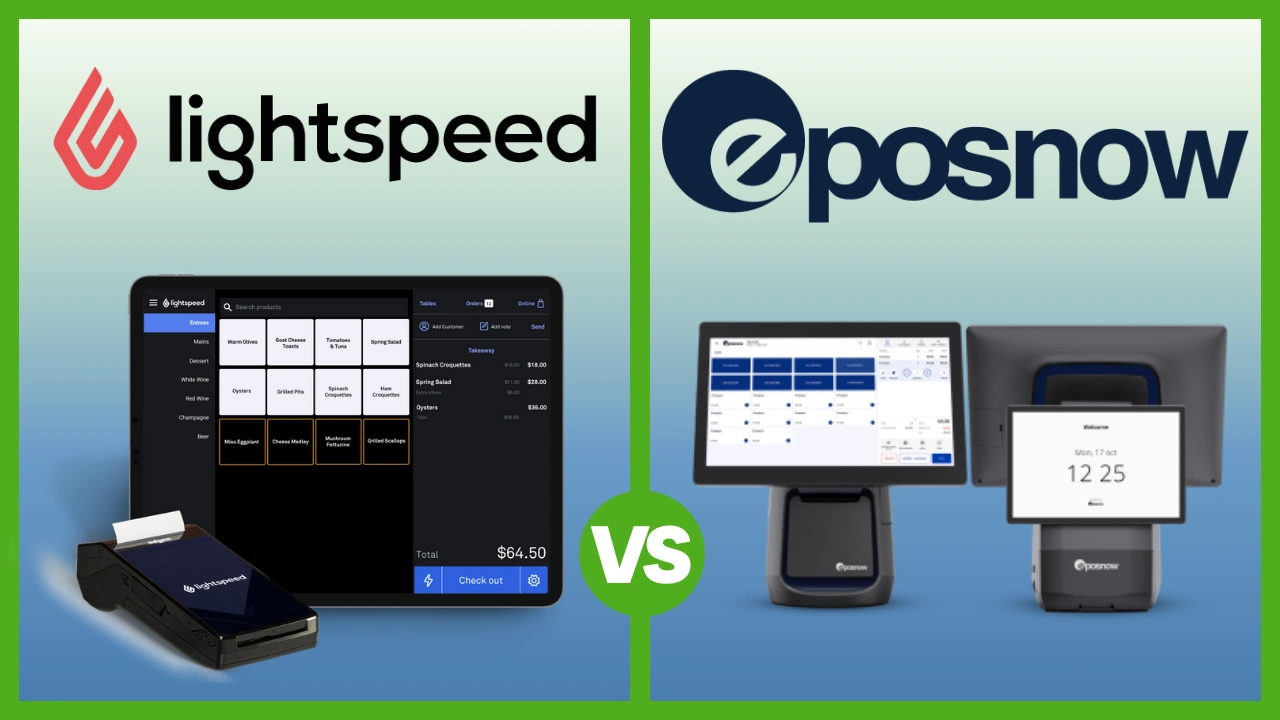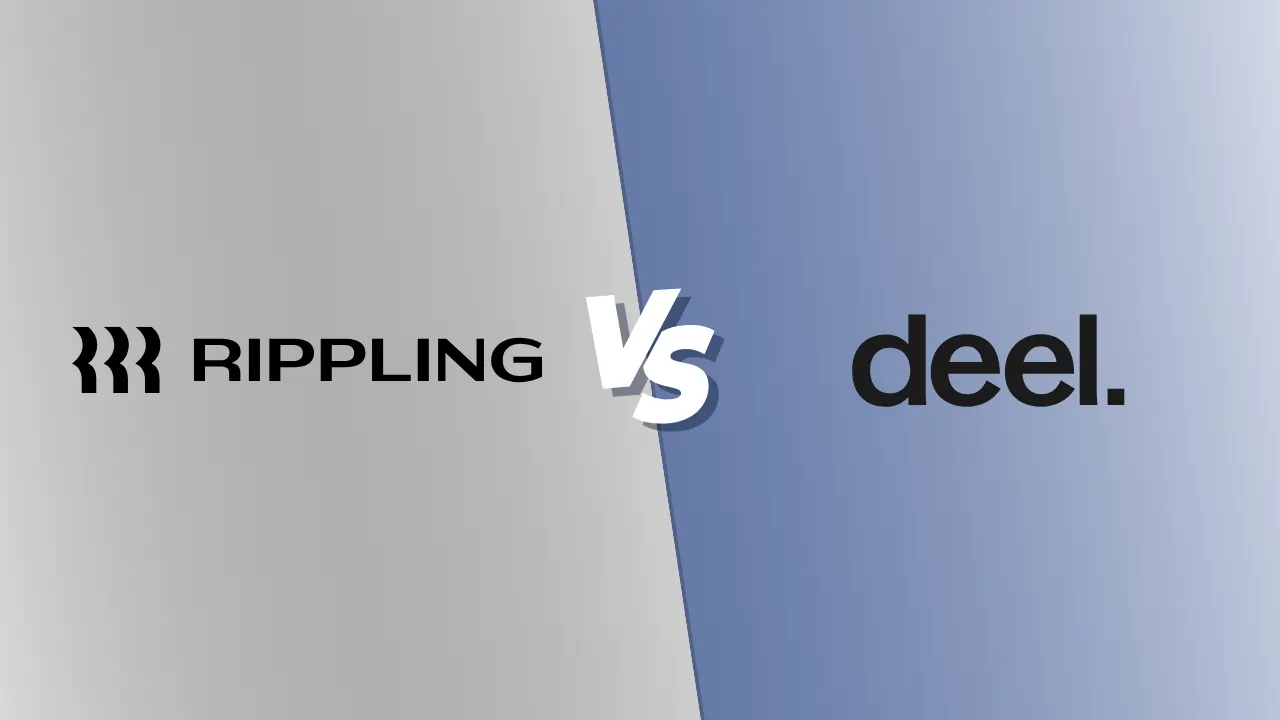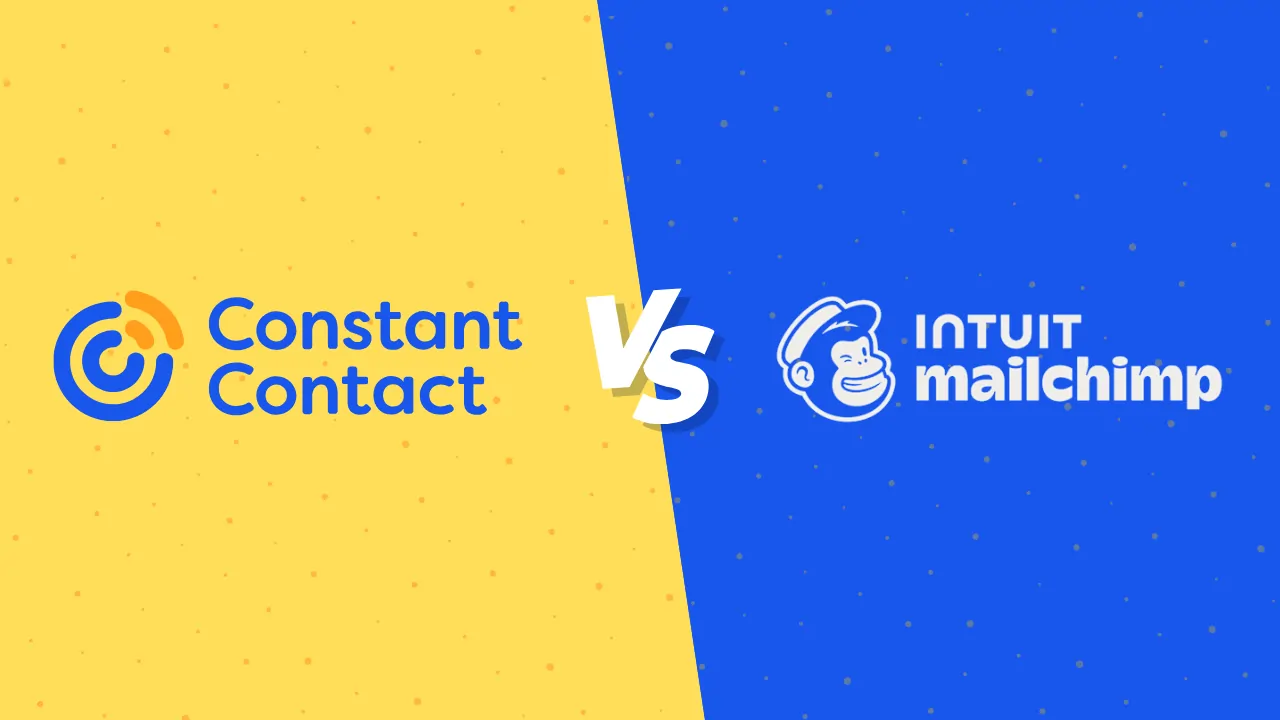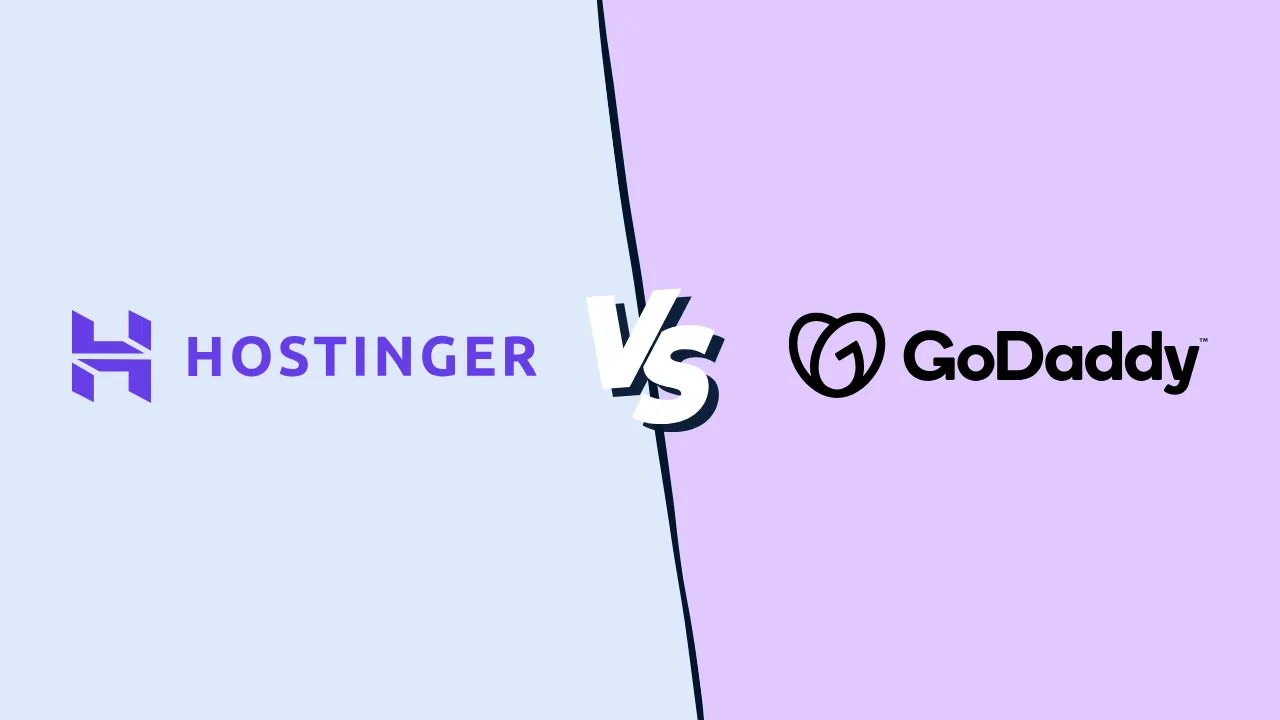Lightspeed vs Epos Now POS (2025): Which fits your retail or hospitality business best?

When choosing between Lightspeed POS and Epos Now, it’s not just about processing payments — it’s about managing data, inventory, and growth.
Lightspeed is known for its advanced analytics, inventory control, and Ecommerce integration. Epos Now emphasizes simplicity, quick setup, and affordability across hospitality and retail sectors.
This detailed comparison examines real-world performance — pricing, features, analytics, and scalability — to help you choose the system that fits your business goals in 2025.
Key points
- Lightspeed is built for growing retailers, restaurants, and multi-location businesses that need advanced analytics, inventory depth, and omnichannel capabilities.
- Epos Now offers a more budget-friendly, plug-and-play solution designed for quick deployment in retail and hospitality settings.
- Lightspeed provides superior inventory management, reporting, and Ecommerce integration; Epos Now focuses on simplicity, low cost, and flexibility across industries.
- Lightspeed suits data-driven businesses seeking scalability; Epos Now suits cost-conscious operators that value ease of use and transparent pricing.
- Both offer cloud-based POS platforms, 24/7 support, and mobile compatibility, but differ significantly in depth, control, and customization.
Market position & use cases
Lightspeed targets modern retailers and hospitality groups that rely on detailed analytics and unified inventory. It’s a strong fit for multi-location operations and omnichannel sellers combining physical and online stores.
Epos Now markets itself to small and mid-sized businesses needing a fast, intuitive POS. Its main draw is affordability and versatility — used by cafés, pubs, salons, and retail stores worldwide.
Fact-based summary:
Lightspeed wins with data depth and scalability. Epos Now wins with accessibility, straightforward pricing, and quick setup.
Quick comparison table
|
Feature |
Lightspeed POS |
Epos Now POS |
|
Primary focus |
Retail & hospitality with advanced analytics |
Retail & hospitality with simple setup |
|
Best for |
Growing, data-driven businesses |
Budget-conscious SMBs |
|
Hardware |
iPad-based or Lightspeed terminals |
Android/iPad POS kits or touchscreen terminals |
|
Inventory management |
Advanced (multi-store, variants, suppliers) |
Core inventory tools, barcode scanning |
|
Ecommerce |
Native Lightspeed Ecom platform |
Shopify, WooCommerce, or Epos Now Online Store |
|
Analytics & reporting |
Deep financial & operational dashboards |
Standard sales and performance reports |
|
Payment processing |
Lightspeed Payments (integrated) |
Epos Now Payments or third-party gateways |
|
Pricing model |
Tiered, industry-specific plans |
Transparent monthly/annual plans |
|
Support |
24/7 global support & onboarding |
24/7 phone & chat support |
|
Scalability |
Multi-location & omnichannel ready |
Easy to expand; limited enterprise control |
Takeaway:
Lightspeed offers enterprise-level analytics and control; Epos Now delivers affordability and speed for everyday SMB operations.
Hardware & device ecosystem
|
Category |
Lightspeed |
Epos Now |
|
Hardware options |
iPads, desktops, Lightspeed terminals |
Epos Now touchscreen terminals, tablets, and handhelds |
|
Design focus |
Modular; optimized for retail and restaurant workflows |
Compact, all-in-one POS kits for fast setup |
|
Peripheral support |
Barcode scanners, printers, scales, card readers |
Compatible with receipt printers, scanners, drawers |
|
Offline mode |
Yes — continues operations offline |
Yes — stores data locally until back online |
|
Setup |
Requires onboarding and configuration |
Self-installation or remote assistance available |
Verdict:
Lightspeed’s modular design favors flexibility and enterprise scalability; Epos Now provides simplicity and fast installation for smaller teams.
Core feature suite & depth
Lightspeed
- Advanced inventory: track variants, bundles, suppliers, and reorder points.
- Purchase order automation and stock transfers between locations.
- Integrated CRM with loyalty and customer segmentation.
- Ecommerce integration with unified stock and order sync.
- Employee management with time logs and role-based permissions.
Epos Now
- Simple inventory tracking with import/export capabilities.
- Built-in customer database and loyalty options.
- Quick product and menu setup for retail or hospitality.
- Optional add-ons: online ordering, delivery, and accounting.
- Multi-till and user management tools for small chains.
Verdict:
Lightspeed excels in inventory precision and data insight; Epos Now focuses on easy daily management for staff with minimal configuration.
Reporting, analytics & insights
Lightspeed
- Custom dashboards with profit margins, turnover, and employee KPIs.
- Real-time sales tracking and performance reporting across locations.
- Deep analytics on customer lifetime value, product mix, and stock turnover.
Epos Now
- Core reporting on sales, products, and staff performance.
- Exportable reports to Excel or accounting systems.
- Simple graphs and daily summaries for quick insights.
Verdict:
Lightspeed provides superior analytics for growth planning. Epos Now offers essential visibility for day-to-day decision-making.
Integrations, ecosystem & extensibility
- Lightspeed: Open API and strong integration library with QuickBooks, Xero, Mailchimp, and Ecommerce platforms. Ideal for multi-tool setups.
- Epos Now: Integrates with major business tools like Sage, Shopify, and Deliveroo, plus a growing App Store of industry add-ons.
|
Factor |
Lightspeed POS |
Epos Now POS |
|
Number of available integrations |
200+ (Retail, Restaurant, and Hospitality APIs) |
100+ curated business add-ons |
|
Open API access |
Yes – advanced developer documentation available |
Yes – limited access via partner program |
|
Best for |
Businesses with complex, multi-system setups |
SMBs seeking simple plug-and-play integrations |
|
Standout capabilities |
Deep ERP, CRM, and analytics integrations |
Seamless accounting, loyalty, and delivery apps |
|
Ease of integration |
Requires technical setup for advanced APIs |
One-click installs via App Store |
Verdict:
Lightspeed has broader developer support and API access. Epos Now provides sufficient integrations for SMBs seeking straightforward connections.
AI, automation, and smart tools
Lightspeed
- Predictive analytics for sales trends and reordering.
- Automated purchase orders and low-stock alerts.
- Smart dashboards identifying best-performing items and staff.
Epos Now
- Automated end-of-day reports and notifications.
- Low-stock and reorder alerts.
- Rule-based automations (discount triggers, time-based pricing).
Verdict:
Lightspeed leads in smart data and predictive analytics; Epos Now automates operational basics effectively.
Pricing, payment processing & contract structure
|
Aspect |
Lightspeed |
Epos Now |
|
Software plans |
Retail & Restaurant tiers from ~$89/month |
POS software from ~$44/month |
|
Processing fees |
~2.6% + 10¢ via Lightspeed Payments |
Flat 1.7% + $0.05 via Epos Now Payments (UK/US vary) |
|
Hardware |
Sold separately or in bundles |
Full POS kits from ~$599 (or monthly lease) |
|
Contracts |
Monthly or annual plans |
Monthly or annual; discounts for annual |
|
Free trial |
Yes (14 days) |
Yes (30 days) |
Summary:
Epos Now is more transparent and budget-friendly upfront. Lightspeed’s plans cost more but include deeper analytics, automation, and multi-location functionality.
Support, reliability & uptime
Lightspeed
- 24/7 global support via phone, chat, and email.
- Personalized onboarding and dedicated account management for enterprise clients.
- Cloud-hosted servers with 99.9% uptime SLA.
Epos Now
- 24/7 customer support and live chat.
- Remote setup assistance and free online training.
- Cloud infrastructure with offline transaction backup.
Verdict:
Both deliver high reliability. Lightspeed offers more white-glove onboarding; Epos Now provides easier DIY setup and faster start.
Scalability & multi-location management
Lightspeed: Centralized control for multi-store operations with synchronized pricing, stock, and analytics dashboards.
Epos Now: Supports multi-site management but lacks real-time data synchronization across large networks.
Verdict:
Lightspeed is enterprise-ready for multi-location management; Epos Now scales affordably for smaller chains.
Real-world use cases and examples
Case 1 – Expanding retail chain
Growing retail operations require the management of multiple outlets, thousands of SKUs, and online sales channels that all need to stay in sync. Each location often maintains distinct inventory levels, supplier relationships, and promotional strategies, making centralized oversight essential for maintaining accuracy and profitability.
Best fit: Lightspeed, for its centralized inventory management, detailed analytics, and seamless Ecommerce integration that unify in-store and online operations.
Case 2 – Independent café or salon
Independent cafés, salons, and boutiques typically prioritize ease of setup, affordability, and minimal training time. Daily operations revolve around fast transactions, appointment scheduling, and simple stock management — all without needing technical expertise or complex configuration.
Best fit: Epos Now, for its plug-and-play setup, low-cost hardware, and intuitive interface that supports quick service and smooth customer interactions.
Case 3 – Multi-concept hospitality group
Hospitality groups that manage multiple concepts — such as restaurants, bars, and retail counters under one brand — face the challenge of unifying data across distinct service models. Shared reporting, inventory coordination, and sales forecasting are key to maintaining consistency and profitability across varied outlets.
Best fit: Lightspeed, for its unified reporting, centralized management, and advanced forecasting tools designed to handle complex, multi-venue operations.
Final verdict & recommendation table
|
Best choice |
Why |
|
|
Pricing transparency |
Epos Now |
Clear monthly pricing and lower hardware cost |
|
Inventory control |
Lightspeed |
Advanced SKU and supplier tracking |
|
Analytics & forecasting |
Lightspeed |
Deep reporting and predictive insights |
|
Ease of setup |
Epos Now |
Plug-and-play simplicity |
|
Ecommerce Integration |
Lightspeed |
Native Lightspeed Ecom and third-party sync |
|
Multi-Location Scalability |
Lightspeed |
Enterprise-grade centralized control |
|
Budget-Friendly for SMBs |
Epos Now |
Lower cost and flexible deployment |
Summary:
Choose Lightspeed for data depth, eCommerce, and enterprise-level scalability.
Choose Epos Now for cost efficiency, simplicity, and fast setup.
FAQ: Lightspeed vs Epos Now POS (2025)
1. Which is cheaper over five years, Lightspeed or Epos Now?
Epos Now is generally cheaper for small businesses, with lower software and hardware costs. Lightspeed costs more but provides greater value for scaling operations.
2. Which POS offers better inventory management?
Lightspeed—it supports multi-store stock, variants, purchase orders, and supplier data. Epos Now handles standard stock tracking.
3. Does Lightspeed include Ecommerce?
Yes. Lightspeed offers an integrated Ecommerce platform for Retail plans. Epos Now connects to Shopify or WooCommerce via integrations.
4. Which is easier to install and train staff on?
Epos Now—self-installation and setup can be completed in under an hour. Lightspeed onboarding typically involves guided configuration.
5. Which offers better reporting tools?
Lightspeed, with detailed dashboards, profit/loss analytics, and predictive insights. Epos Now provides core sales and staff reports.
6. Can both systems run offline?
Yes. Both queue transactions offline and sync when back online.
7. Which scales better for multiple locations?
Lightspeed, thanks to centralized control and real-time cross-location data.
8. Can Epos Now integrate with online stores?
Yes, through Shopify, WooCommerce, and its native Epos Now Online Store module.
9. Which offers better customer support?
Both provide 24/7 support. Lightspeed offers personalized onboarding; Epos Now offers quicker, self-service deployment.
10. Which POS is best for restaurants and cafés?
Epos Now is better for smaller venues and quick-service setups; Lightspeed Restaurant is better for larger, data-driven establishments.




